19th century
| | This section is empty. You can help by adding to it. (July 2010) |
This article lists (in chronological order) notable events in the history of botany in Britain.
"A new Herball, wherin are conteined the names of Herbes ... with the properties degrees and naturall places of the same, gathered and made by Wylliam Turner, Physicion unto the Duke of Somersettes Grace" is the complete name of his great work of botany. The first part was published in London, printed by Steven Myerdman in 1551), the second was published in 1562 and the third in 1568, both in exile in Germany, by Arnold Birckman of Cologne. These volumes were the first clear and systematic investigation of the plants of England. The work had admirable wood engravings (basically copied from Leonhart Fuchs' work De historia Stirpium, 1542) along with the detailed observations obtained by Turner in his field studies. At the same time, Turner included a list of the "uses and virtues" of plants and in the preface admits that he may be accused of disclosing to the general public what should have been reserved for a professional audience. Thus for the first time a flora of England in the vernacular was available, so that most English plants could easily be identified.
| | This section is empty. You can help by adding to it. (July 2010) |
| | This section is empty. You can help by adding to it. (February 2013) |
| | This section is empty. You can help by adding to it. (February 2013) |
| | This section is empty. You can help by adding to it. (February 2013) |
| | This section is empty. You can help by adding to it. (February 2013) |
| | This section is empty. You can help by adding to it. (February 2013) |

Sir Joseph Dalton Hooker was a British botanist and explorer in the 19th century. He was a founder of geographical botany and Charles Darwin's closest friend. For twenty years he served as director of the Royal Botanical Gardens, Kew, succeeding his father, William Jackson Hooker, and was awarded the highest honours of British science.
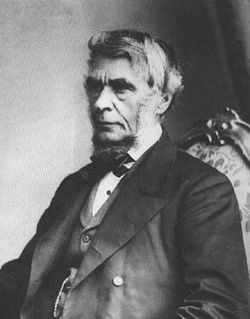
George Bentham was an English botanist, described by the weed botanist Duane Isely as "the premier systematic botanist of the nineteenth century". Born into a distinguished family, he initially studied law, but had a fascination with botany from an early age, which he soon pursued, becoming president of the Linnaean Society in 1861, and a fellow of the Royal Society in 1862. He was the author of a number of important botanical works, particularly flora. He is best known for his taxonomic classification of plants in collaboration with Joseph Dalton Hooker, his Genera Plantarum (1862–1883). He died in London in 1884.

William TurnerMA was an English divine and reformer, a physician and a natural historian. He has been called "The father of English botany." He studied medicine in Italy, and was a friend of the great Swiss naturalist, Conrad Gessner. He was an early herbalist and ornithologist, and it is in these fields that the most interest lies today. He is known as being one of the first "parson-naturalists" in England.

Sir William Jackson Hooker was an English botanist and botanical illustrator, who became the first director of Kew when in 1841 it was recommended to be placed under state ownership as a botanic garden. At Kew he founded the Herbarium and enlarged the gardens and arboretum. The standard author abbreviation Hook. is used to indicate this person as the author when citing a botanical name.

John Gerard was an English herbalist with a large garden in Holborn, now part of London. His 1,484-page illustrated Herball, or Generall Historie of Plantes, first published in 1597, became a popular gardening and herbal book in English in the 17th century. Except for some added plants from his own garden and from North America, Gerard's Herbal is largely a plagiarized English translation of Rembert Dodoens's 1554 herbal, itself highly popular in Dutch, Latin, French and other English translations. Gerard's Herball drawings of plants and the printer's woodcuts are mainly derived from Continental European sources, but there is an original title page with a copperplate engraving by William Rogers. Two decades after Gerard's death, the book was corrected and expanded to about 1,700 pages.

A herbal is a book containing the names and descriptions of plants, usually with information on their medicinal, tonic, culinary, toxic, hallucinatory, aromatic, or magical powers, and the legends associated with them. A herbal may also classify the plants it describes, may give recipes for herbal extracts, tinctures, or potions, and sometimes include mineral and animal medicaments in addition to those obtained from plants. Herbals were often illustrated to assist plant identification.
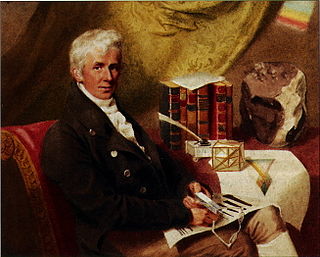
James Sowerby was an English naturalist, illustrator and mineralogist. Contributions to published works, such as A Specimen of the Botany of New Holland or English Botany, include his detailed and appealing plates. The use of vivid colour and accessible texts were intended to reach a widening audience in works of natural history. The standard author abbreviation Sowerby is used to indicate this person as the author when citing a botanical name.

John Lindley FRS was an English botanist, gardener and orchidologist.

Mathias de l'Obel, Mathias de Lobel or Matthaeus Lobelius was a Flemish physician and plant enthusiast who was born in Lille, Flanders, in what is now Hauts-de-France, France, and died at Highgate, London, England. He studied at the University of Montpellier and practiced medicine in the low countries and England, including positions as personal physicians to two monarchs. A member of the sixteenth-century Flemish School of Botany, he wrote a series of major treatises on plants in both Latin and Dutch. He was the first botanist to appreciate the distinction between monocotyledons and dicotyledons. The Lobelia plant is named after him.
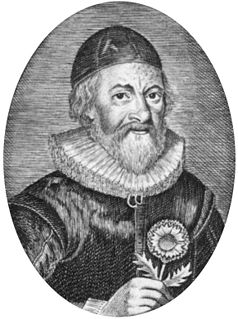
John Parkinson was the last of the great English herbalists and one of the first of the great English botanists. He was apothecary to James I and a founding member of the Worshipful Society of Apothecaries in December 1617, and was later Royal Botanist to Charles I. He is known for two monumental works, Paradisi in Sole Paradisus Terrestris, which generally describes the proper cultivation of plants; and Theatrum Botanicum, the most complete and beautifully presented English treatise on plants of its time. One of the most eminent gardeners of his day, he kept a botanical garden at Long Acre in Covent Garden, today close to Trafalgar Square, and maintained close relations with other important English and Continental botanists, herbalists and plantsmen.
John Goodyer (1592–1664) was a botanist who lived in south-east Hampshire, England, all his life. He amassed a large collection of botanical texts which were bequeathed to Magdalen College, Oxford, and translated a number of classical texts into English.
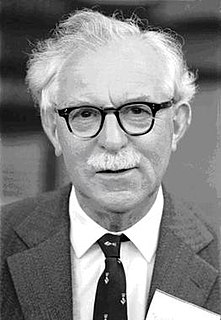
William Thomas Stearn was a British botanist. Born in Cambridge in 1911, he was largely self-educated, and developed an early interest in books and natural history. His initial work experience was at a Cambridge bookshop, but he also had a position as an assistant in the university botany department. At the age of 29 he married Eldwyth Ruth Alford, who later became his collaborator, and he died in London in 2001.

William Henry Harvey, FRS FLS was an Irish botanist and phycologist who specialised in algae.
The history of phycology is the history of the scientific study of algae. Human interest in plants as food goes back into the origins of the species, and knowledge of algae can be traced back more than two thousand years. However, only in the last three hundred years has that knowledge evolved into a rapidly developing science.
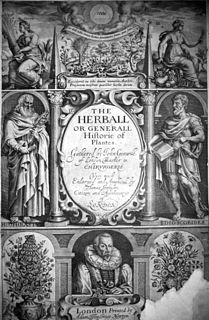
Thomas Johnson was an English botanist, and a royalist colonel in the English Civil War. He has been called the "father of British field botany".

Henry Lyte was an English botanist and antiquary. He is best known for two works, A niewe Herball (1578), which was a translation of the Cruydeboeck of Rembert Dodoens, and an antiquarian volume, The Light of Britayne (1588), both of which are dedicated to Queen Elizabeth I.
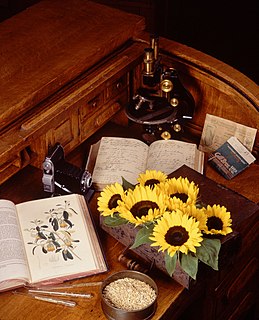
The history of botany examines the human effort to understand life on Earth by tracing the historical development of the discipline of botany—that part of natural science dealing with organisms traditionally treated as plants.

William Hunt Painter was an English botanist who made a significant contribution to the science of Derbyshire vascular plant flora. He was a keen and wide-ranging collector of plant specimens, and was a member of the Botanical Exchange Club. In 1889 he published the first in a series of four books, all by different authors and spanning 120 years, all called The Flora of Derbyshire.
Francis Blackwell Forbes was an American botanist with expertise in Chinese seed-producing plants who also worked as a merchant and opium trader in Asia.

The Grete Herball is an Early Modern encyclopedia and the first illustrated herbal produced in English. It is preceded by Richard Banckes's unillustrated Herball (1525), which was the first printed English herbal ever produced. The Grete Herball is a single volume compendium which details the medicinal properties of plants and some non-botanical items according to the system of humoralism. Confirmed editions were printed between 1526 and 1561, with many still in existence today. Its full title is "The grete herball: whiche geueth parfyt knowlege and under standyng of all maner of herbes & there gracyous vertues whiche god hath ordeyned for our prosperous welfare and helth: for they hele & cure all maner of dyseases and sekenesses that fall or mysfortune to all maner of creatoures of god created: practysed by many expert and wyse maysters, as Aucienna & other &c."